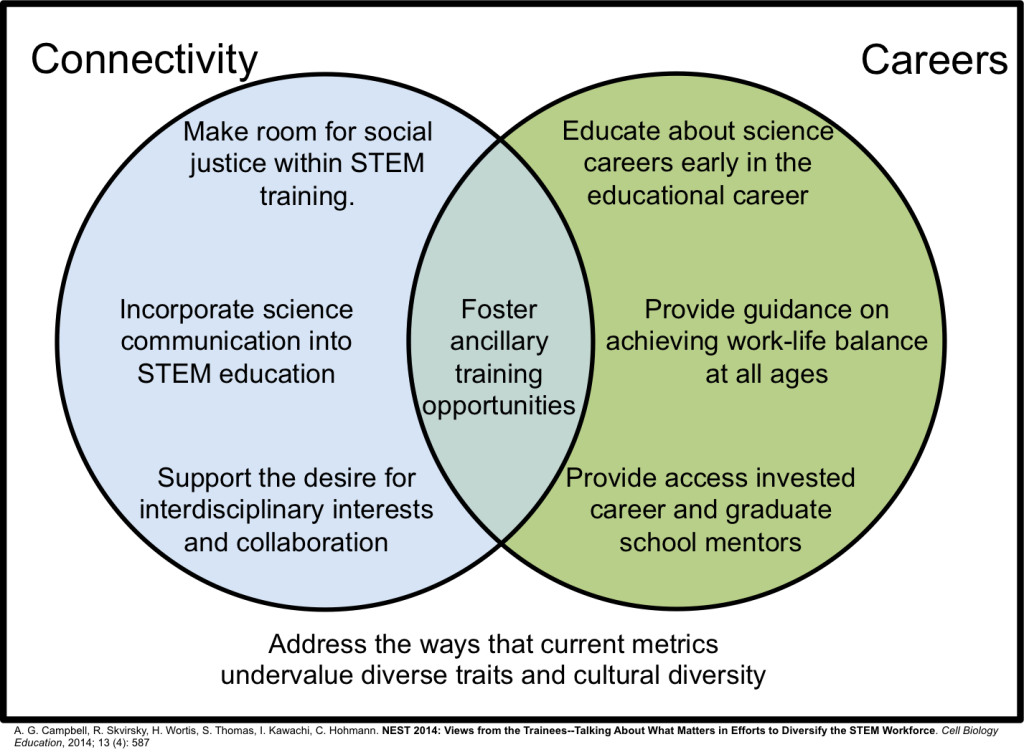A friend of mine is providing career counseling as I slog through the job market like a salmon struggling upstream. She’s my “fish ladder” to help me get around obstacles.
I realize that the analogy breaks down around the end because I’m not going to croak from fatigue once I land a job. But it’s hard, and a feat of endurance, and there are lots of us floundering through the current. I can do it, though. I’m cool. I’ve got skills. I’m hireable. But in the meantime, I’m going to write.
This floundering seems to be a common theme with anyone I talk to about getting a job. I managed to push through my Ph.D. and completed successfully, but I am, for now, done with academia. Lately, I’ve been curious about the deterrents and obstacles other people of color face that keep them from pursuing STEM careers. A report released today addresses this very question.
A research team lead by Andrew G. Campbell chose to tackle the issue of underrepresentation of minority people in STEM by taking a novel approach: they asked minority students. The methods may sound obvious, and that approach has indeed been implemented before through surveys and questionnaires, but the authors were cognizant of the fact that those kinds of tools are inherently biased. Whoever designed the questions is looking at the problem from a particular perspective, and this will inevitably impact the results. This team, instead, asked open-ended questions and allowed the students to reach consensus amongst themselves about the barriers they faced to pursuing STEM careers.
The researchers derived a consensus of 50 participants at varying levels of their careers from 15 institutions. Participants were split into groups and allowed to discuss issues surrounding STEM training and career development. For the most part, facilitators took a hands-off approach, and groups elected their representatives. This approach ties in with the research team’s desire to avoid top-down prescriptions.

50 participants collectively came up with eight actionable recommendations about how to encourage underrepresented minority individuals to pursue STEM careers
In the end, the participants came up with eight major recommendations, and because I’m a nerd, a Venn Diagram seemed like the most appropriate way to organize them.
While the desire for career guidance was unsurprising, what struck me was an overarching desire for connectivity. Whether to the wider social world through communication and social change, or for the desire for interconnectivity between disciplines and movements both within and outside of STEM. The students repeatedly recommended changes that would allow for more flexibility and appreciation of diverse interests.
The “foster ancillary training opportunities” point was placed at the intersect of “Connectivity” and “Careers” because it allows students to explore career options in fields related to their own, but not their own. Finding out what you want to do for a career may only happen after you’ve done stuff. The example used in the report was: a Ph.D. student in Pathobiology researching cancer may realize that his/her interests overlap with epidemiology and public health and may wish to pursue training in that field.
This isn’t the first time “connectivity, ” and “contextual” science teaching have been a concern for POCs. A 2007 study by Angela Johnson found that the tradition of teaching science in a decontextualized manner creates a challenging environment for women of color students. It’s a deterrent for many. The teaching style ignores students’ motivations for getting involved in STEM. The women in the 2007 study pursued undergraduate science for many reasons, e.g. as a stepping stone to a career in medicine, or they want to make the world a better place. So teaching science knowledge in a social vacuum assumes that everyone in the class became involved in because they found science fascinating in and of itself and only for that reason.
Science as a culture needs to move away from decontextualized knowledge and towards a more interdisciplinary environment. I suppose this point also addresses the idea of career mentoring as well. If you provide scientific information in context, it may make it easier to see the way that the information fits into the career landscape.
I chose the Campbell study not only because it was recent, but because it resonated with the goals of this blog. I can’t provide any career advice (I’m just as lost as you are), but I can present an interdisciplinary perspective on science. I love science. I find it fascinating and wonderful and beautiful. But it’s all the more engaging and accessible when given a context when the message is accessible and connectable and translated through different disciplines and media. The emerging movement is called STEAM, which stands for Science Technology Engineering Art and Math.
____________________________________________
A. G. Campbell, R. Skvirsky, H. Wortis, S. Thomas, I. Kawachi, C. Hohmann. NEST 2014: Views from the Trainees–Talking About What Matters in Efforts to Diversify the STEM Workforce. Cell Biology Education, 2014; 13 (4): 587 DOI:10.1187/cbe.14-04-0068
Johnson, A. C. (2007). Unintended consequences: How science professors discourage women of color. Science Education, 91(5), 805-821. DOI: 10.1002/sce.20208

1 Comment
Sue Alexander
January 21, 2015 at 1:50 amI am a fishladder! Yaaay! I like the content you have presented so far.